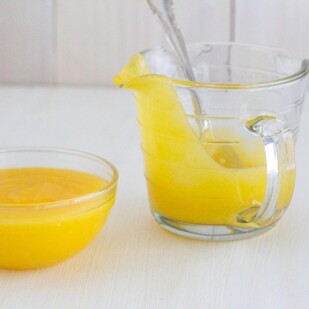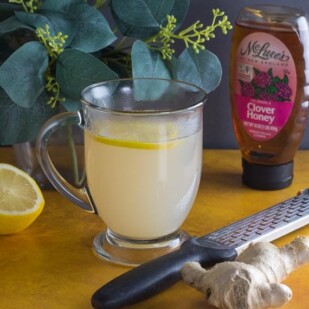Traditional lemon pepper seasoning contains conventional garlic and onion powders, which are high FODMAP. Did you know that there are low FODMAP versions? There are! And they have allowed us to create a Low FODMAP Lemon Pepper Seasoning that we simply adore.
Our low FODMAP Lemon Pepper Seasoning is a classic combination of black pepper, salt, dried lemon peel, a little sugar, and of course, the low FODMAP garlic and onion powder. Please note that it is very pepper forward! If you are not a pepper lover, you might want to choose a different blend, or reduce the black pepper amount.
BTW if you are a lemon fan, be sure to check out our recipe for Preserved Lemons.
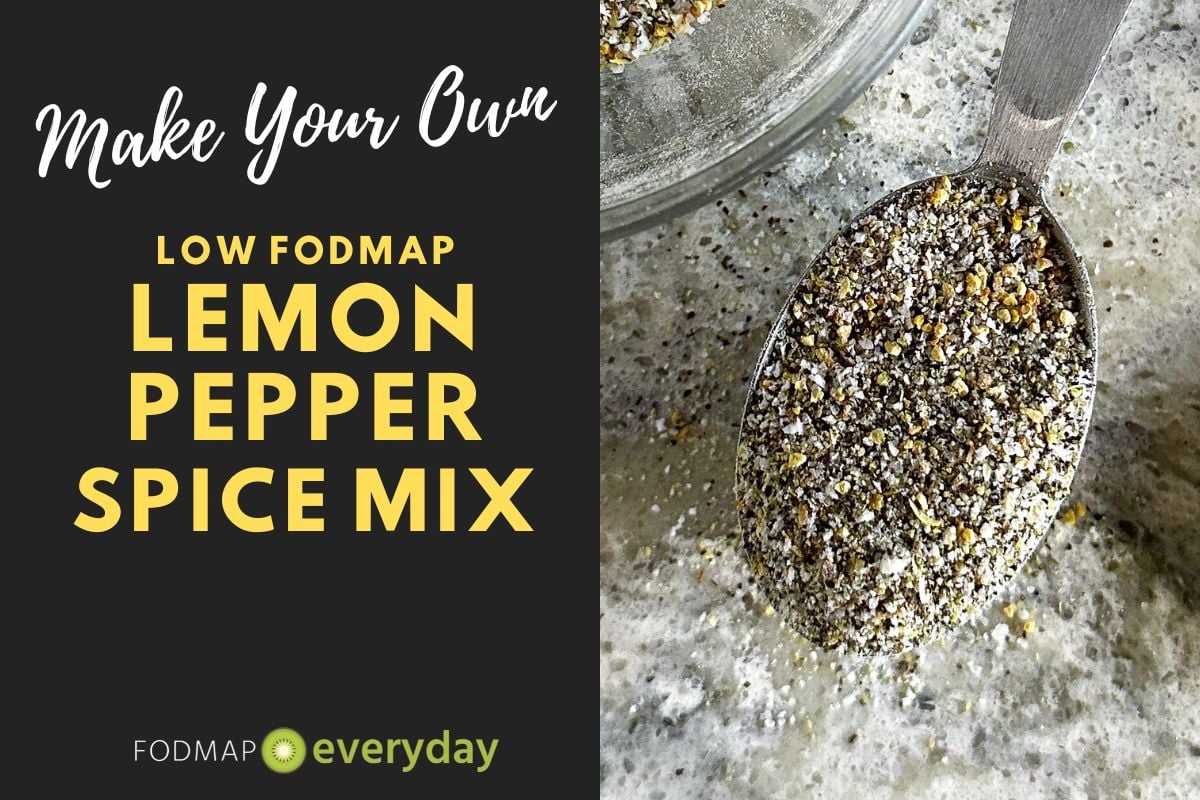
Frequently Asked Questions
Monash University had lab tested fresh lemon peel and the zest of an entire lemon is low FODMAP, and no Moderate or High FODMAP amounts have been assessed. The amount of dried lemon peel in this recipe per serving is considered small enough to not trigger IBS symptoms in most people.
Please note that you need to grind and pulverize the lemon peel before making this seasoning blend; a mortar and pestle works wonders.
Conventional garlic and onion powders are made from dried and granulated, or powdered, garlic cloves or onion and are high FODMAP foods. There are a couple of low FODMAP garlic and onion powders on the market: FreeFod Garlic and Onion Replacers and Fodmazing Garlic or Onion Substitute Replacer. The FreeFod products have been lab tested and is certified low FODMAP by FODMAP Friendly. Both brands contain the same ingredients – maltodextrin and natural garlic or onion flavor. We find them to be excellent additions to your herb and spice collection. Use them as you would conventional garlic or onion powders.
We love it on steak and burgers, but also try it on roasted potatoes, chicken, fish – sky’s the limit.
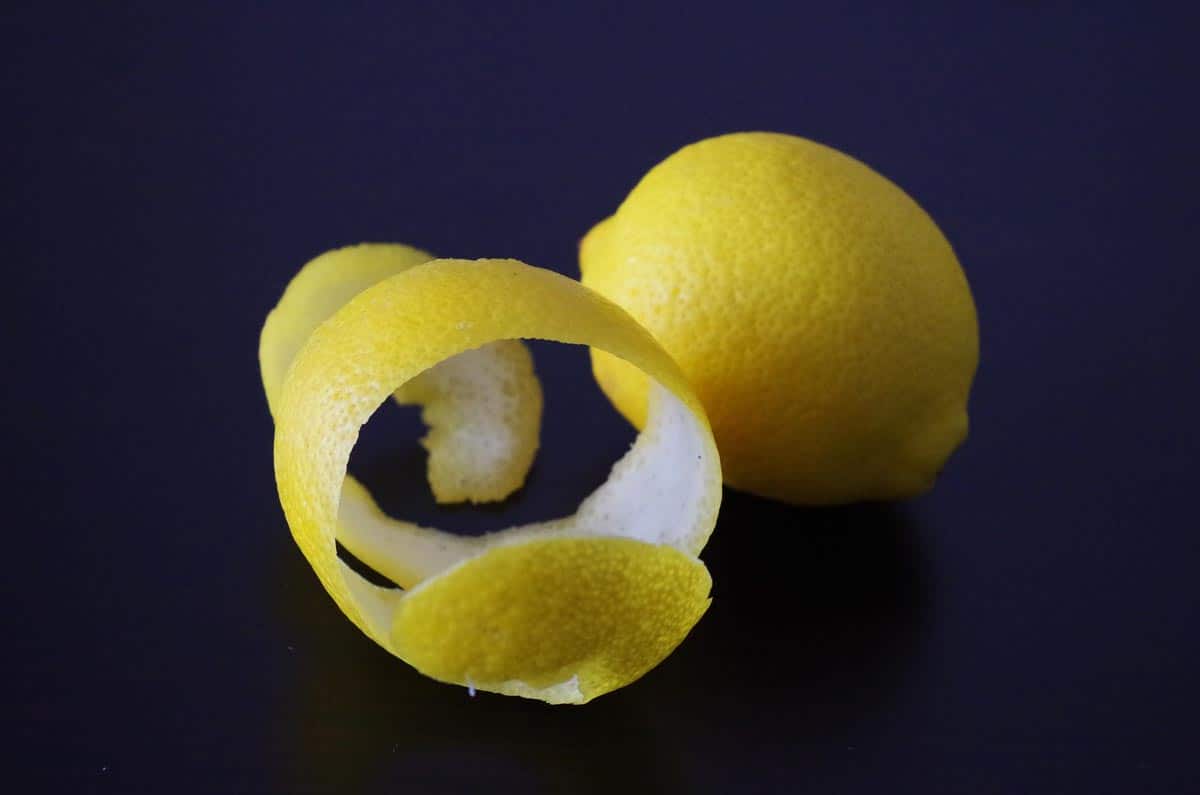
Low FODMAP Seasoning Blend Basics
Please refer to our article, How To Make Low FODMAP Seasoning Blends, for info on purchasing spices, toasting, storage and discussions on whole spices vs. pre-ground, the best tools for grinding your own, measuring, etc.
FODMAP Information
All recipes are based upon Monash University & FODMAP Friendly science at time of initial
- Low FODMAP Garlic Powder: Conventional garlic powder is made from dried and granulated, or powdered, garlic cloves and is considered high FODMAP. There are a couple of low FODMAP garlic powders on the market: FreeFod Garlic Replacer and Fodmazing Garlic Substitute Replacer. The FreeFod has been lab tested and is certified low FODMAP by FODMAP Friendly. Both brands contain the same ingredients – maltodextrin and natural garlic flavor. We find them to be excellent additions to your herb and spice collection. Use them as you would conventional garlic powder.
- Low FODMAP Onion Powder: Conventional onion powder is made from dried and granulated, or powdered, onion and is considered high FODMAP. There are a couple of low FODMAP onion powders on the market: FreeFod Onion Replacer and Fodmazing Onion Substitute Replacer. The FreeFod has been lab tested and is certified low FODMAP by FODMAP Friendly. Both brands contain the same ingredients.
- Sugar: Monash University and FODMAP Friendly have both lab tested white, granulated sugar. Monash states that a Green Light low FODMAP serving size of white sugar is ¼ cup (50 g). FODMAP Friendly simply states that they have tested 1 tablespoon and that it is low FODMAP. Regular granulated white sugar is sucrose, which is a disaccharide made up of equal parts glucose and fructose. Sucrose is broken down and absorbed efficiently in the small intestine.
Please always refer to the Monash University & FODMAP Friendly smartphone apps for the most up-to-date lab tested information. Foods will be retested from time to time; in the case of raw ingredients, such as fruits and vegetables, results may vary. All lab tested results are valid and represent a snapshot in time. As always, your tolerance is what counts; please eat accordingly. The ultimate goal of the low FODMAP diet is to eat as broadly as possible, without triggering symptoms, for the healthiest microbiome.
Flavor For Your FODMAP Cooking
Check out all of our other low FODMAP seasonings, all very easy to make.
- Low FODMAP Everything Bagel Seasoning
- Low FODMAP Cajun Spice Blend
- Low FODMAP Italian Seasoning
- Low FODMAP Taco Seasoning
- Low FODMAP Ethiopian Berbere Spice
- Low FODMAP Sweet BBQ Dry Rub
- Low FODMAP Smoky BBQ Dry Rub
- Low FODMAP Jamaican Jerk Seasoning
- Low FODMAP Tex Mex Seasoning
- Low FODMAP Steak Seasoning
- Low FODMAP Moroccan Ras-el-Hanout Spice
- Low FODMAP Mediterranean Za’atar Spice
- Low FODMAP Salt-Free Herb Mix
- Low FODMAP Dry Ranch Seasoning
- Low FODMAP Garam Masala
- Low FODMAP Cumin Allspice Dry Rub
- Low FODMAP Sweet & Spicy Dry Rub
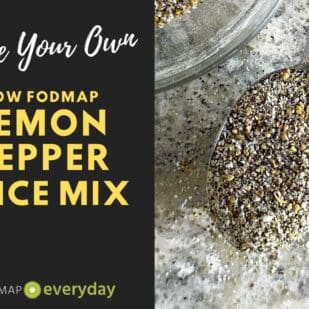
Low FODMAP Lemon Pepper Seasoning
Traditional lemon pepper seasoning contains conventional garlic and onion powders, which are high FODMAP. Did you know that there are low FODMAP versions? There are! And they have allowed us to create a Low FODMAP Lemon Pepper Seasoning that we simply adore.
Low FODMAP Serving Size Info: Makes about cup ¼ plus 1 tablespoon (30 g); 60 servings; ¼ teaspoon per serving
Ingredients:
- 3 tablespoons ground dried lemon peel
- 2 tablespoons freshly ground black pepper
- 2 tablespoons kosher salt
- 1 teaspoon sugar
- 1 teaspoon low FODMAP garlic powder, such as FreeFod or Fodmazing
- 1 teaspoon low FODMAP onion powder, such as FreeFod or Fodmazing
Preparation:
-
In a small mixing bowl, stir together all of the ingredients until well combined.
-
Store in an airtight container in a cool, dark location. Use within 6 months, for best flavor.
Notes:
FODMAP Information
All recipes are based upon Monash University & FODMAP Friendly science at time of initial
• Low FODMAP Garlic Powder: Conventional garlic powder is made from dried and granulated, or powdered, garlic cloves and is considered high FODMAP. There are a couple of low FODMAP garlic powders on the market: FreeFod Garlic Replacer and Fodmazing Garlic Substitute Replacer. The FreeFod has been lab tested and is certified low FODMAP by FODMAP Friendly. Both brands contain the same ingredients – maltodextrin and natural garlic flavor. We find them to be excellent additions to your herb and spice collection. Use them as you would conventional garlic powder.
• Low FODMAP Onion Powder: Conventional onion powder is made from dried and granulated, or powdered, onion and is considered high FODMAP. There are a couple of low FODMAP onion powders on the market: FreeFod Onion Replacer and Fodmazing Onion Substitute Replacer. The FreeFod has been lab tested and is certified low FODMAP by FODMAP Friendly. Both brands contain the same ingredients.
• Sugar: Monash University and FODMAP Friendly have both lab tested white, granulated sugar. Monash states that a Green Light low FODMAP serving size of white sugar is ¼ cup (50 g). FODMAP Friendly simply states that they have tested 1 tablespoon and that it is low FODMAP. Regular granulated white sugar is sucrose, which is a disaccharide made up of equal parts glucose and fructose. Sucrose is broken down and absorbed efficiently in the small intestine.
Please always refer to the Monash University & FODMAP Friendly smartphone apps for the most up-to-date lab tested information. Foods will be retested from time to time; in the case of raw ingredients, such as fruits and vegetables, results may vary. All lab tested results are valid and represent a snapshot in time. As always, your tolerance is what counts; please eat accordingly. The ultimate goal of the low FODMAP diet is to eat as broadly as possible, without triggering symptoms, for the healthiest microbiome.
Nutrition
All nutritional information is based on third-party calculations and should be considered estimates. Actual nutritional content will vary with brands used, measuring methods, portion sizes and more. For a more detailed explanation, please read our article Understanding The Nutrition Panel Within Our Recipes.
